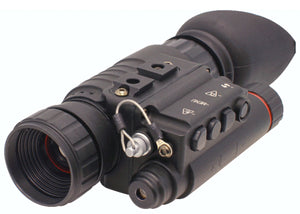- Home
- THERMAL IMAGING OPTICS
- 1X (hands-free goggle standard)

Thermal Imaging Optics
Like the Gen1+, Gen2+ and Gen3 image intensifiers that are at the heart of night vision, thermal imagers depend on sensors (called focal plane arrays) which cleverly convert wavelengths of heat energy that are invisible to our eyes into something we can see.In fact thermal imagers don't "see" anything. Rather, they detect minute differences in heat - as small as 0.01°C - which they display as a monochrome shade of grey on their internal black and white video monitors.
The heat that is detected by thermal sensors generally comes from one of two sources. The first, referred to as "heat signatures", are actively generated by objects such as warm blooded animals, engines and machinery. The second source of heat energy sensed by thermal imagers comes from inanimate objects such as rocks, buoys and vegetation which passively release the heat they absorb from the sun at different rates.
24-Hour Thermal Vision Scopes, Thermal Binoculars, Thermal Hunting Scopes
Because thermal energy is the only wavelength of interest to a thermal imaging device, they work equally well night and day. Indeed, because thermal imagers are unaffected by the contrast issues that can plague night vision viewers (i.e. the problem of visualizing a dark object against a dark background) they can often outperform night vision.Thermal imagers could care less about visual contrast. All that they require to "see" is either a heat signature or a minute temperature differences between objects. For applications that require exceptional imaging 24-hours a day regardless of condition, thermal imaging handscopes, binoculars and hunting scopes are often the best choice.
THERMAL IMAGING OPTICS
Filter Products
Core Technology
- Thermal Imaging Scopes
- Thermal Imaging Binoculars
- Thermal Imaging Goggles
- Thermal Imaging Hunting Scopes
- Clip-On Thermal Imaging Scopes
- Thermal Heat Sensors
Thermal Range
Thermal Sensor Refresh Rate
Magnification
Optical / Power / Environmental Features
Digital Features
Exportable?
Product Brand
GSCI TI-GEAR-M Multi-Purpose Thermal Imaging Scopes | Exportable | ITAR-free
Thermal Imaging Scope
From
$5,689.00
GSCI TI-GEAR-M Thermal Imaging Mono-Goggles. Exportable and ITAR-free.
Thermal Imaging Scope
From
$5,945.00



